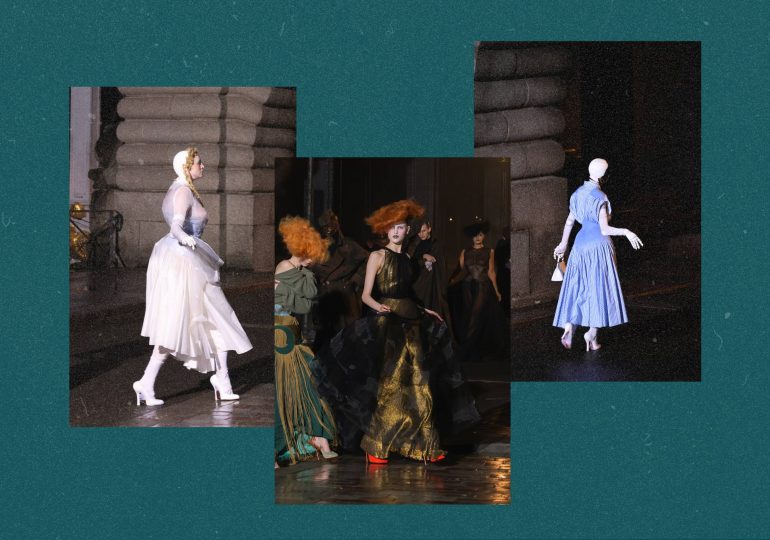In the Spring/Summer 2024 Maison Margiela artisanal show during Paris fashion week in January, British designer John Galliano stunned the fashion world with a collection that featured innovative tailoring and theatrics that hearkened back to his renowned runway shows in the 1980s and 1990s. Inspired by the portraiture of Brassaï, the show aimed to capture “a walk through the underbelly of Paris, offline.” After his fall from grace in 2011 following multiple antisemitic drunken outbursts, an event that resulted in a court sentencing and sacking from his job as creative director of Dior, Galliano was kicked out of this elite fashion club. This vibrant new collection has vaulted Galliano back onto the front pages of high fashion.
[time-brightcove not-tgx=”true”]
Galliano’s continued appeal hinges on the way he uses history in his designs. Pulling audiences into a specific moment with intricate staging and dramatic silhouettes, he connects people to the evolution of commodity culture. As Galliano’s latest show and career make clear: fashion is intimately connected to this history of modern consumption, urbanization, and technology.
Read More: The Top 10 Fashion Moments of 2023
Galliano has long referenced the links between fashion and the formation of capitalist societies. Fashion is a poignant medium to address these connections because of the key role it played in industrialization. Historian Sven Beckert, for example, explains that the cotton and textile industry fueled the creation of global capitalism. Textiles were some of the first products to be processed in factories, most notably in Britain. Cotton textiles, as well as inventions that facilitated their production, like the cotton gin and power loom, spurred innovation in mechanized products.
Galliano’s rise to fame in the 1980s and 1990s was in part achieved by designs that placed historical themes at the forefront. Many of his most famous collections recalled the 19th century as a period of both luxury and instability. As commercialization accelerated in major European capitals, new areas of public leisure like department stores altered class and gender relationships. In Paris, department stores and window displays encouraged consumers to fantasize about owning new and exciting products. Innovations in manufacturing and production facilitated higher rates of consumption among the middle class. For women in London, the West End was an area to engage with an urban culture that was both emancipatory and oppressive as shopping became increasingly feminized.
In the 1990s, Galliano drew on these “ghosts of earlier forms of commodity capitalism” to comment on anxieties surrounding the acceleration of global consumption and environmental crises, explains historian Caroline Evans. The 1990s saw the advent of several groundbreaking inventions including the widespread use of the internet in 1993 and the first mobile phones. These technological leaps inaugurated a vastly different and connected world, just as the telephone and internal-combustion engine did in the 19th century.
Moreover, the fashion world in the 1990s was also transforming, shifting away from a relatively small market of family businesses to a global industry, spearheaded by the notorious head of the conglomerate LVMH, Bernard Arnault. Galliano’s runway attire in the 1990s often counteracted these commercial priorities as he incorporated silhouettes like the bias-cut which were difficult to reproduce in the factory. These tailor-made designs served as a response to a rapidly globalizing industry, even if critics often accused Galliano of creating non-wearable and impractical clothing.
Today, Galliano carries these same anxieties about commodity culture into his most recent collection. The 2024 Maison Margiela show represented a call back to a once-great period of Galliano fame, as the collection displayed familiar techniques of staging, choreography, and theatrical makeup that typified his runway shows in the 1990s. These references cater to Gen Z, a generation enamored with 1990s nostalgia which has caused a resurgence in styles like low-rise jeans. Just days after the show, fans had made their own versions of Galliano outfits and staged runway shows in their living rooms. A number of tutorials on how to achieve models’ glass skin doll-inspired look by one of Galliano’s long-time collaborators, make-up artist Pat McGrath, spread across the internet.
While Galliano may be effectively nodding to the 1990s to reinvigorate his own career, his return to these themes continues his critique of the globalization of fashion. Today, the dominant problem is the proliferation of cheaply made products known as “fast fashion.” Galliano’s designs react against the mass production of fashion by focusing on complex tailoring that can only be done by hand rather than machine. The collection featured no less than 15 tailoring techniques, eight newly created by Galliano himself. The 19th century saw a similar backlash. The Arts and Crafts Movement emerged in 1875 as a counter to what was perceived as poor quality of materials caused by factory production. By evoking his designs in the 1990s, Galliano continues to use the same tactics—calling upon historical silhouettes from moments of industrial change—to comment on the nature of commodity culture today.
Galliano’s legacy is still unwritten. A new documentary chronicling his tumultuous fashion career, titled High and Low: John Galliano released on March 8 in the United States and the streaming platform Mubi. His antisemitic outbursts in Paris and dismissal from Dior will always be a significant part of his legacy, a point the documentary includes. While much of the press around Galliano is no doubt part of a reputation-rebuilding campaign, his consistent referencing of the past is essential to the appeal of his designs. Fashion has historically been a captivating method with which to process weighty questions about the effects of consumer capitalism and globalization. Galliano’s future is still in question, yet his work proves that fashion is an essential arena for people to reckon with crisis and change.
Margot Rashba is a Ph.D. candidate in history at Boston University. Her research centers on dress and fashion in 20th century Britain.
Made by History takes readers beyond the headlines with articles written and edited by professional historians. Learn more about Made by History at TIME here. Opinions expressed do not necessarily reflect the views of TIME editors.
Leave a comment








